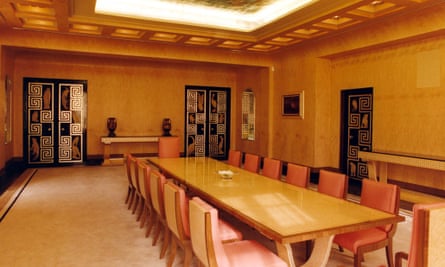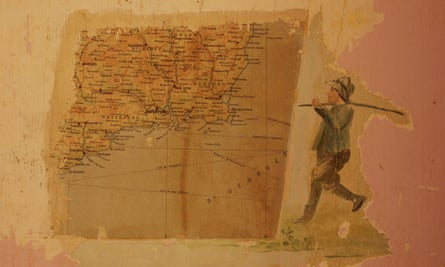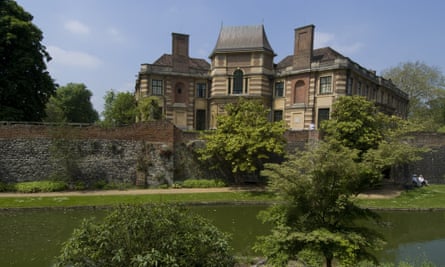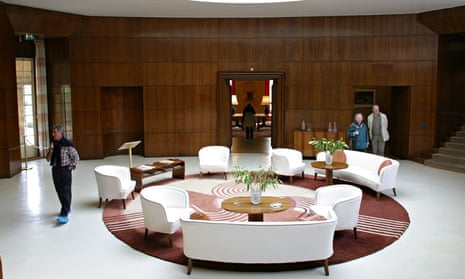In the late 15th century, when it was home to a boy who would become Henry VIII, and again in the 1930s, when it became an art-deco party house for the textile millionaire Stephen Courtauld and his wife, Virginia, Christmas was a hectic time at Eltham Palace, as it filled with holly and ivy, candles and firelight, the kitchens working flat out and the great hall filling with guests.
At first glance the great hall so familiar to Henry, who enjoyed many childhood celebrations at Eltham, looks miraculously unchanged under its great hammerbeam roof, the third largest in England, built for Edward IV in the 1470s. But the historian Andrew Hann stoops and pats the stone flagged floor to reveal one of the innovations introduced by Courtauld when he took on the property in the 30s. On a cold winter evening, the slabs are not as icy as expected: this is a medieval hall with underfloor heating.

“We’ve learned a great deal about life in this house from people who visited or worked here, and we’re trying to put back some of that history,” Hann says, of the £1.7m that English Heritage has put forward for a conservation project at Eltham Palace, the first since it completed an extensive programme of repairs and restoration after it took over the property in 1995.
The plan is to open previously unseen parts of what must rank as one of its most eccentric properties: a state-of-the-art 1930s mansion attached to a 15th-century hall, surrounded by a Tudor moat, deep in suburban southeast London.
When Henry VIII became king in 1509 he found his waterfront palace at Greenwich more convenient and Eltham fell into decline. It was used as a barn in the 18th century, and by the early 20th century it was an indoor tennis court. In 1933 Courtauld – brother of Samuel, who founded the Courtauld Institute – controversially gained permission to build a new house in the grounds provided he restored Eltham’s medieval hall.
John Seely and Paul Paget were an unusual choice of architects. They had excellent society connections, as heir to a title and son of a bishop respectively, and after the second world war they became known for sensitive restoration work on bombed churches. However, in 1933 their firm was only six years old, and Eltham was their first major project.

They combined traditional materials with green-painted metal-framed windows, while carvings including Courtauld’s hiking boots, and art deco interiors with a concrete and glass dome over the circular entrance hall. Many people hated the result: one critic thought it looked more 20th-century industrial than a suitable neighbour for a medieval palace, and called it “an admirably designed but unfortunately sited cigarette factory”.
Engineering historians say the house was probably the most advanced in England when it was finished in 1936. It used technology borrowed from luxury ocean liners, and featured a plumbed-in vacuum cleaner driven by a motor in the cellars, a heated jungle-fresco room for the couple’s pet lemur Mah Jongg, centrally powered electric clocks, speakers relaying radio or gramophone records to every room, built-in cocktail bars, sliding walls to protect an art collection that included several Turner watercolours, and an internal and external telephone exchange.
The marriage between Virginia, a divorced Italian socialite, and the reserved Stephen was as eccentric as the house. Her bedroom, where her huge walk-in wardrobe is being restored, is all film star glamour with a gold tiled bathroom. His bedroom, beyond a connecting door, is monastically plain. Stephen’s library, to which he frequently removed in mid-sentence when dinner party chit-chat bored him, had only an internal phone built into the panelling, but Virginia needed five outside lines on her desk to organise her life. Most decadent of all, and astonishing to guests, the house had plentiful, luxurious and warm bathrooms.
The restoration work is literally peeling back the layers of history in the map room, where a secretary worked planning the Courtaulds’ long cruises on their luxury yacht.

To the astonishment of conservator Sarah Lambarth, a series of unsuspected, fragile 1930s wall paintings is emerging from under layers of paint and wallpaper, featuring Japanese maidens, Balinese temples, and an Irishman with a shillelagh.
Eltham was always a property built for parties. In 1499 the humanist scholar Erasmus was furious when Sir Thomas More took him there without mentioning they were calling on a royal household. More brought a piece of writing as a gift for Henry, whose “certain royal demeanour; I mean a dignity of mind combined with a remarkable courtesy”, Erasmus noted. “The boy, during dinner, sent me a note inviting something from my pen,” Erasmus wrote. “I went home, and though the Muses from whom I had lived apart so long were unwilling, I finished a poem in three days.” Henry was eight at the time.
In the 1930s a visitor recalled how weekend visits began at Friday afternoon tea with a brandy bottle on the table to add a slug to each cup. At a dinner for the Duchess of York in 1936 the Courtaulds served a 1923 Veuve Clicquot champagne, and she wrote later: “I must say that I thought some of the modern part a little overdone – but it was all very interesting and my goodness what a good feed we had! And good champagne!”

When the second world war broke out the fun continued in one of the most luxurious bunkers of any private house, which will also open to visitors for the first time next year. It had a bar, a larder, a sound system and an adjoining frescoed billiard room. It was not only bomb-proof but, because of Courtauld’s nightmare experience of being gassed in the Artists Rifles during the first world war, gas-proof too, with a sophisticated air exchange system. “Everyone was sure of a warm welcome with or without previous notice of their arrival or ration cards,” one happy guest recalled of the war years.
In 1944, after just eight years, it all ended. Despite Courtauld’s vigils on the roof of the great hall as an air raid warden, the building suffered when more than 100 incendiary bombs fell on the estate, they were down to their last two gardeners, and Virginia Courtauld was depressed following the death on active service of her nephew Paul. The Courtaulds gave the remaining 88 years of their lease to the Army School of Education, and moved first to Scotland, and then to Southern Rhodesia, modern Zimbabwe.
However, the parties clearly continued: when the army moved out and English Heritage moved in, it found a bar built into every ground floor room – one last survivor, a 1960s bar added to the bunker, is now being removed as part of the restoration work.
